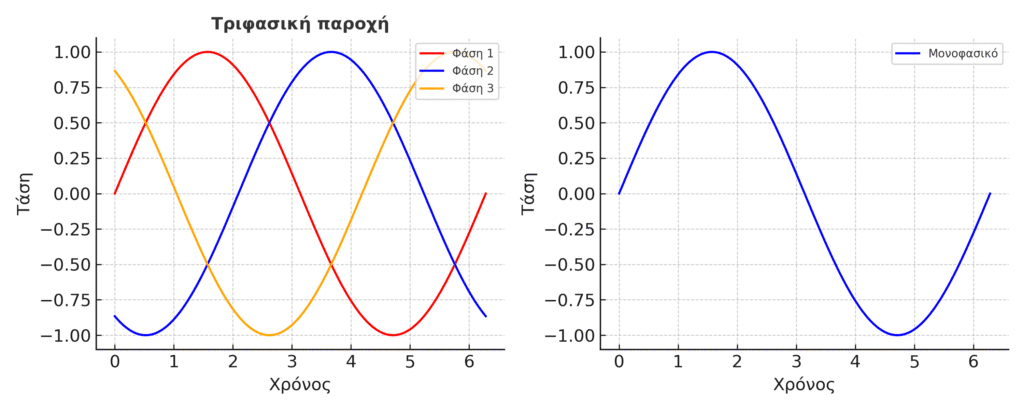The power supply of a property is a critical factor for its smooth operation, whether it is a residence or a professional facility. The fundamental decision a consumer must make concerns the choice between single-phase and three-phase supply. While both cover different needs, the right choice can save costs, ensure stability, and optimize the daily use of electricity.
Single-phase power: The solution for residential needs
Single-phase power is the most common form of supply in Greece and is mainly used in apartments and small houses. It is based on one phase and neutral, providing 230V voltage. It is a simple and economical solution that can easily cover everyday needs such as lighting, small household appliances, televisions, and computers.
However, single-phase power has certain limitations. The power it can provide reaches a specific limit (about 8–10 kVA), which makes it insufficient in cases where multiple or energy-intensive devices are used simultaneously. Thus, in a household with an electric stove, large air conditioners, or a heat pump, single-phase power may lead to frequent overloads and interruptions.

Three-phase power: The choice for higher demands
Three-phase power consists of three phases and a neutral, with a total supply of 400V. It is widely used both in industry and in residences with greater needs. Its main advantage is the ability to provide much higher power, allowing energy-intensive devices to operate simultaneously without issues.
Additionally, thanks to the even distribution of the load, three-phase power ensures more stable supply and reduces the risk of cable overheating and panel failure. For this reason, it is preferred in professional spaces, workshops, laboratories, and even in modern homes equipped with multiple air conditioning units or heating systems using electric heat pumps.
Selection criteria: What to consider
The decision between single-phase and three-phase supply is not random but based on three main factors:
Type of property: A small apartment is usually covered by single-phase power, while a maisonette or a house with many electrical appliances may require three-phase.
Energy needs: If you use high-power devices (such as ovens, professional tools, heat pumps, or large air conditioners), three-phase power is the only solution.
Future expansion: If you are planning future projects, such as installing photovoltaics, electric vehicle charging, or professional use of the property, three-phase power offers greater flexibility.
The choice between single-phase and three-phase power is not just a technical matter but a strategic decision with a direct impact on your daily comfort and operating costs. Single-phase remains the most economical and simplest solution for typical residential needs, while three-phase is the ideal choice in cases of higher demands, professional use, or future upgrades.
Proper assessment of each case requires a technical study by a certified electrician. This ensures that the installation will be safe, efficient, and fully adapted to your needs.
📞Contact us
We have the expertise and experience to assess your energy needs and propose the most suitable solution, with safety and reliability.
